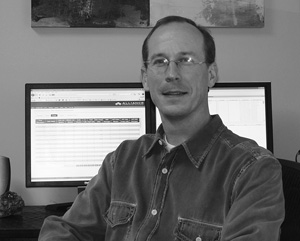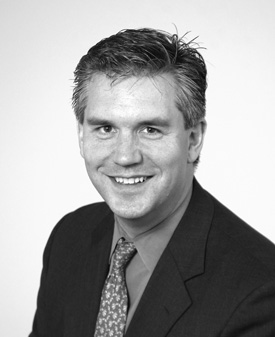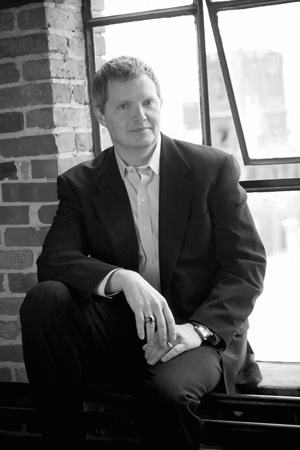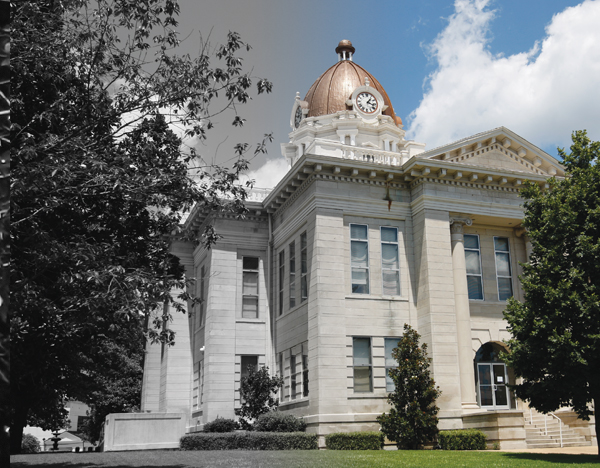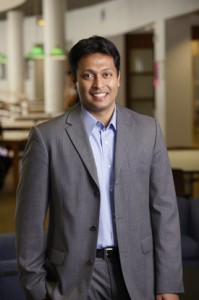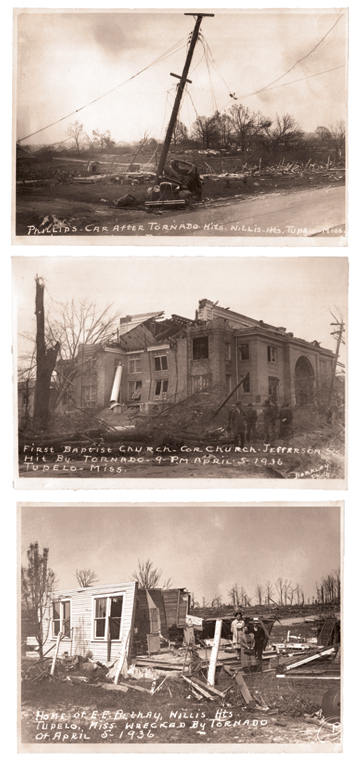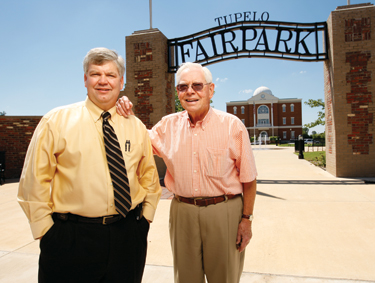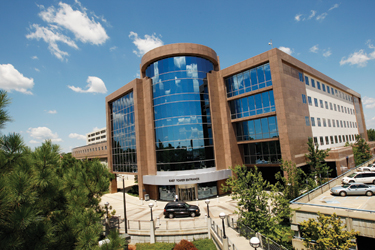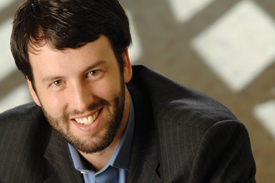 Ray Sumner, MBA’10, woke up in a bed with white sheets. He recognized his mother, who was holding his right hand. She had traveled from their family farm on Staten Island to keep vigil at his bedside in Bethesda Naval Hospital.
Ray Sumner, MBA’10, woke up in a bed with white sheets. He recognized his mother, who was holding his right hand. She had traveled from their family farm on Staten Island to keep vigil at his bedside in Bethesda Naval Hospital.
Sumner did not know she would be there. Until someone told him, he did not even know where “there” was. The last thing he remembered was being with his unit, the 25th Marine Division, on the debris-strewn streets of Haditha, Iraq. It was the 11th week of his second tour in the country, and his battalion was engaged in house-to-house operations in the heart of the Sunni Triangle—one reason the 25th sustained the highest casualty rate of any outfit during the war.
Sumner remembers clearly how an insurgent ran out of a house and fired off a few quick rounds as the Marines were clearing a block. One bullet struck Sumner in the right hip, severing an artery. He was in a coma for 10 days. And then, suddenly, he found himself in Bethesda, Md.
The Marines never leave one of their own behind. For Sumner, who spent 18 years as an officer, the reverse is also true. Despite the injuries and rehabilitation, he would sign up again tomorrow if the Marines called him. Sumner still misses it. In some sense that is a big part of what attracted him to the Owen School.
How is Owen like a military enterprise? The question may seem odd to someone who has never worn the uniform. But to veterans who earned MBAs at Vanderbilt after earning their stripes, the connections seem obvious. For four of them—among the surprisingly large number who gravitate to this relatively small business school—seeing those connections made all the difference in their choice to enroll and in the directions their careers have taken.
For Ray Sumner it was the camaraderie—“the biggest thing I missed about the military,” he says. “I looked at other big-name schools. Vanderbilt is extremely competitive but friendly. The others were hostile-competitive.”
Sumner particularly remembers his first campus visit in 2008. “I immediately felt like I was part of the Owen family,” he says. “That’s how the Marine Corps is. It’s the smallest branch of the service. Very close-knit. You get to know a lot of the other officers.”
Life Mission
Kyle Clay, MBA’09, by contrast, was not looking for something small. Ever since he was a football star and three-sport athlete in Lima, Ohio, Clay sought opportunities to be involved with something larger than himself. That is one reason why he accepted a scholarship to play football at West Point, and why he was drawn to the health care field after his military commitment ended.

In between his graduation from the U.S. Military Academy and Owen, parts of his service experience were a reminder why the old Chinese saying “may you live in interesting times” was originally intended as a curse.
In June 2003 Clay arrived at an abandoned water purification plant near Baghdad. The soldiers called it Dogwood, but it might have been more accurately named Hell. There was no running water. No air conditioning. Temperatures routinely surpassed 110 degrees.
“You’d get to midday and just want to take a nap because you couldn’t get anything done,” remembers Clay, who was a lieutenant in the 54th Engineer Battalion. “Nothing could have prepared me for Iraq.”
Clay and his men lived off prepackaged rations, or MREs. Sometimes, when they had to pick up arriving soldiers and supplies, they would navigate the deadliest stretch of highway in Iraq—dubbed “RPG Alley” for the prevalence of rocket-propelled grenades—and grab some hot food at the airport, where, almost surreally, there was a Burger King.
Among Clay’s responsibilities was leading convoys—an innocuous-sounding job that was a very dangerous assignment in Iraq. The supply convoys traveled under constant threat of attack from improvised explosive devices (IEDs). His convoy was hit only once during his first six months, but tension soared every time they ventured onto the roads.
Clay’s second deployment to Iraq made the first tour look civilized. Stationed in Ramadi and Fallujah, scenes of the war’s most intense fighting, Clay was assigned to “route clearance”—an Army euphemism for bomb removal.
You can create your own path at Owen. After nine years of a very strict environment, it was a great place for me to try a smattering of academic and extracurricular activities.
—Kyle Clay
Clay soon realized how increasingly sophisticated the insurgents’ techniques had become during the year he was back on base in Germany. “Some IEDs were buried deep enough that our equipment couldn’t detect them,” he says. One, he remembers, was planted in a manhole. It detonated as a vehicle in his battalion passed over it. The manhole cover rocketed through the underside of the vehicle, killing and wounding several soldiers. In all, he lost seven men in 12 months. All told, his engineer battalion removed 1,000 IEDs.
Even before he came home from Iraq, Clay knew he wanted to go to business school. He had become interested in health care—something that, to him, was more than just business. That led him to Owen, where he found the change he sought and the continuity he needed.
Like the Army, he says, Owen is extremely collegial, and there is a sense of purpose even among students with different career aims and areas of focus. For example, with colleagues involved in Project Pyramid, the student-led initiative to alleviate global poverty, Clay had the opportunity to travel to Bangladesh. “Even in Iraq, I’d never been face-to-face with such poverty,” he says. “It was life-changing.”
In contrast to the Army, Owen’s Health Care MBA program is extremely entrepreneurial, Clay says: “You can create your own path. After nine years of a very strict environment, Owen was a great place for me to try a smattering of academic and extracurricular activities.”
It is a far cry from Dogwood, but Clay is today, once again, in the desert—Phoenix, to be exact—where summer temperatures can reach a Baghdad-like 114 degrees. As a Regional Operations Director for DaVita, North America’s largest operator of kidney dialysis centers, Clay oversees 11 in-center dialysis clinics and two home programs.
“The position demands a very different type of management from the Army,” he says. And yet, he adds, “I entered into an environment not unlike the military. We are all focused on one mission.”
That mission is life. Without dialysis or a kidney transplant, every patient with end-stage renal disease will die. With dialysis, they can live, work and stay with their families. “That’s what gets me excited about this company,” Clay says. “We are a community first and a company second.”
The name DaVita comes from an Italian phrase that roughly translates as “he or she gives life.” Clay likes the sound of it. For someone who has traveled so closely with death, it feels good to be surrounded by givers of life.
Anchors Aweigh
As a boy, Henry Guy, MBA’98, had the power to determine whether kids in his community would have to attend school. Guy grew up on Smith Island, off Maryland’s Eastern Shore. He was the son of a son of a son of a fisherman who caught blue crabs and oysters in the Chesapeake Bay.
Getting to school involved an hour’s trip by boat. The boat’s captain had a policy for rough weather: If even one kid wanted to make the trip, the school boat would run.
“My parents were very focused on education,” Guy explains. “It didn’t matter if there was a hurricane out there, it was, ‘Get up and get on the boat.’ So on days when it was extremely windy, the neighborhood kids would congregate in our yard to see if I was going to go, and when I walked out, they’d all moan, ‘Aww, man.’ A couple of times they even booed.”

But Guy did not let this singular power go to his head. Even in the relatively small pond of Crisfield High, he looked up to others as role models—especially one older boy whom he remembers as “all the things I tried to be.” When that student pursued a spot in one of the service academies, Guy’s interest was piqued.
Guy eventually enrolled at the U.S. Naval Academy, where he was struck immediately by how accomplished so many of his fellow students already were. His first-year roommate, an Iowan, was fluent in Russian and spent his summer as an interpreter overseas. “There were guys who went on to Rhodes Scholarships or completed their graduate education while at the academy,” says Guy, who was a teammate of future NBA star David Robinson on Navy’s basketball team. “A number of experiences like that made me think, ‘Wow, if you work hard and take advantage of the opportunities put in front of you, that opens the door to a host of new opportunities.’”
He brought that mindset to his first posting as a division officer aboard the USS Comte de Grasse, a destroyer named for the French admiral whose blockade of Yorktown helped win the Revolutionary War. The Comte de Grasse focused on maritime interdiction: looking for Caribbean drug smugglers, patrolling the Red Sea to intercept materials headed for Iraq, or boarding ships in the Adriatic to stop weapons from reaching combatants during the Balkan wars.
Meanwhile, remembering his lesson from the academy, Guy soaked up all the knowledge he could from rotations involving various systems and areas of the ship’s operations. Every duty was an opportunity. It helped him move up to become an aide to an admiral, a coveted position for a junior officer.
That mentality also helped him choose Vanderbilt when his five-year commitment ended. “I very much considered myself to be raw material,” he says. “I knew nothing about the business world I’d soon be entering. The mod system allows you to take many more classes than a traditional semester system. That was very appealing to me because I felt like I had so much to learn. Every mod, I got permission to take extra classes. I wanted to sample everything out there.”
In other ways, too, the Owen experience built on what Guy liked most about the Navy. He liked the way that much of the work at Owen was team-oriented, just as it was aboard a ship. He also liked the way that Owen’s “approach is focused on how we get people to go out and be contributors right away. It’s not a stamp. Everything is structured so that it wraps itself around the individual rather than being a one-size-fits-all factory.” It was the right way to do things, Guy believes, and that, too, created continuity. “At the Naval Academy,” he explains, “there’s a huge focus on doing things the right way, honoring the legacy of the past.”
The mindset from the academy and from Owen carried over into Modern Holdings, the New York investment firm he founded. As President and CEO, Guy believes the right way to run a business is to work as a team and to think long term. “We’re not a traditional private equity firm,” he explains. “We invest our own money, and that makes for a different decision-making process. We don’t look to flip companies. To me, the value is how we can help grow the business over time.”
More than anything, Guy’s approach has its roots on Smith Island. Modern Holdings typically buys closely held family enterprises. Because he grew up around such a business, he holds a special appreciation for them. Fishermen, he reflects, are not merely people who ply a trade. “They’re entrepreneurs,” he says. “They’re huge risk takers who are up against a formidable competitor—Mother Nature.”
Leaping at an Opportunity
For Lindsey White, MBA’10, jumping out of airplanes turned out to be especially relevant preparation for Owen. A self-described “Army brat” who split her childhood between Germany, Oklahoma, North Carolina and Tennessee, she grew up literally wanting to follow in the footsteps of her father, a paratrooper in the 101st Airborne. As a young girl, she would practice by sliding her feet into his big boots and hurtling off the living room sofa.
So, after White enrolled at the U.S. Air Force Academy, it was not surprising that she volunteered for jump school. “The first time I jumped,” she recalls, “was a frightening experience. You don’t know up or down. You’re just falling and counting and remembering when you are supposed to pull this cord. By the third time, it’s a little more automatic. On my fourth jump, the chute got twisted, but by then I knew what to do.”
White earned her jump wings but never had to leap from a plane again. After graduating from the academy, she oversaw airfield operations—a duty that also required certification as an air traffic controller—at bases from Florida to California.

When her five-year commitment ended, “I decided to try something new,” she says. “I felt like I’d been in the military my whole life.” Eventually she put her operations expertise to work as a project manager for a California company that designs and builds large-scale water features, including the landmark fountains at the Bellagio casino in Las Vegas.
There, she realized she needed to learn more. “Much of what I knew centered on the military and people management,” White says. To reach higher levels in the business world, she needed to broaden her skills. That realization led her to Vanderbilt.
“Everyone on staff seemed concerned about the fit of the students,” she says. “It made me feel that if I was selected to join Owen, it had something to do with who I was and how I could contribute and learn from the other students.”
That first mod, White recalls, was like her first jump. Learning to be a student again after eight years was challenging. “It’s not like a work assignment,” she says. “You can’t just shut it out when you get home like you can after a day at the office.”
But after the first month, as with the first few parachute drops, something clicked. “I found I had made great friends and was sharing a unique experience,” she says. “I fell into the day-to-day (and evening) routine and never looked back.”
After a summer internship in the corporate world, White realized she missed some of the structure military life provided. She won a two-year Presidential Fellowship with Voice of America (VOA), the U.S. government’s official radio and television broadcasting service, in Washington, D.C. The new job offers her the best of both worlds. Within the security of her position, she has opportunities to complete rotations in other areas besides her specialty, operations, as training that may prepare her ultimately to take over a division of VOA. It is like being able to jump from a plane, with none of the uncertainty.
Of course, White’s new position is not without stress, but her Air Force experience taught her a valuable lesson in dealing with it. “In air traffic control your life is about stress,” she says. “Nowadays when somebody comes into your office and says this is a life-or-death situation, I can say, ‘No, it’s not. Let’s talk about it.’”
Brothers in Arms
Jumping remains part of Ray Sumner’s life. He loves the adrenaline rush that comes from hurling himself off a cliff, his survival depending on a strand of bungee cord. He has jumped from three of the world’s highest bungee-accessible sites: Bloukrans, South Africa; Victoria Falls, Zimbabwe; and Interlaken, Switzerland.

Somehow jumping fills a longtime need. The love of flying, with or without a vehicle, is what led Sumner to the Marines in the first place. While he was still in ROTC at St. John’s University, the Corps guaranteed him a seat in flight school if he passed a test. He passed and went on to train on T-34 jets and pilot helicopters.
Sumner left the Marines after 13 years but rejoined in 2003, after a General Officer phoned one morning and told him, “Your country needs you.” In between he operated a fledgling import business in handmade goods from some of the exotic locales he had visited with the Corps, like Yemen. The business barely broke even. But, as an entrepreneur, Sumner had found a civilian avocation that could satisfy his need for flowing adrenaline.
When I got out of the Marine Corps, I thought I’d never have this again. The camaraderie at Vanderbilt is unique. That’s why I’ll always appreciate it.
—Ray Sumner
Now he is returning for another jolt—this time as a beer maker with an MBA. He learned the brewer’s art from his younger brother. After taking a new product development class, he realized he might have a new product of his own. He began testing its viability at Owen get-togethers. “At one party,” he recalls, “I brought 26 different types of beer. People were saying, ‘Where can I buy this stuff?’”
With help from Owen’s entrepreneurship program, Sumner test-marketed his quaffs in the wider community. This summer he was busily researching properties around Nashville and as far afield as Austin, Texas, and Portland, Ore. To Sumner, it feels like an exhilarating jump, and his MBA colleagues are his bungee. They are continually providing support and advice, offering to serve on the board of his company for free, helping him assess logo designs, and serving as sounding boards for ideas.
That is the thing, Sumner says, about Owen. “When I got out of the Marine Corps, I thought I’d never have this again. The camaraderie at Vanderbilt is unique. That’s why I’ll always appreciate it. There were a lot of students who perhaps were smarter than me and whom Owen could have accepted into the program, but they chose me to be part of the family. When somebody gives you a chance like that, you don’t forget it. And that’s the Marine Corps way.”












 Academics often like to talk about providing “real-world experience” for their students, but the real estate program at the Owen School has ventured beyond the standard rhetoric.
Academics often like to talk about providing “real-world experience” for their students, but the real estate program at the Owen School has ventured beyond the standard rhetoric. Building a program
Building a program


